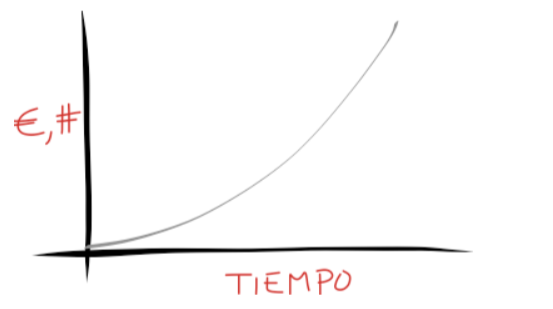TRACTION.
MEASURE YOUR GROWTH
Accelerate your business with these expert tips on "Traction. Measure your growth". Analyse and discover this TIP!
Traction" is a term used in the world of startups (+) to describe the progress or advancement of your company on its way to success. Refers to the your company's ability to generate demand and attract a wide and diversified audience. Solid traction is a indicator that a startup is solving a real and relevant problem and is ready to scale and grow.
WHAT IS TRACTION AND WHY IS IT SO IMPORTANT FOR A STARTUP?
Traction is a metrics on the progress of the real-world validation of your business model (+) and it is a must if you are looking for investment, but do you know how it works and what an investor expects to see?
WHY IS TRACTION SO IMPORTANT FOR AN INVESTOR?
LET'S START WITH THE FIRST THING. A GOOD DEFINITION OF TRACTION COULD BE:
"Metrics that show how well (or poorly) you are taking your business model to market and how well it is being accepted by your customers".
And although right now you may think it's about how much money you make, in reality it's much more. It's about the "momentum" of your startup, how well your business model is resonating with customers... and the basis for that is having a good product that addresses real problems for your customers. If you launch your product to the market and there is hardly any traction, maybe it's time to pivot your business model (before your company ends up in the land of the living dead). zombies (+). Already, but I don't care if I'm not going to look for investment, because I'm a follower of the bootstrapping (+)?
Well, I'm sorry to tell you, it's exactly as critical, because traction is not only necessary if you are looking for investors: traction is important because it shows that your great idea is really taking root with your customers, that there is a real demand for your product in the market... in other words, that it is reasonably validated, which is key before making new decisions about the future of the company. And, for an investor, it shows results, that you are more than just a charlatan who knows how to sell his idea very well.
In practice this means:
- What you do matters to someone.
- There is a market.
- There are customers willing to pay.
- You have validated at least part of your business model (sales channels, minimum viable product, etc.).
- You are able to build a product.
- You are able to execute and bring your business model to market.
- You have managed to get experienced/referential people "on board".
Traction is all of the above, but obviously, the The relative importance of these factors depends very much on your business model. What you need to be clear about is that this is not a metric to impress, we are not talking about your ego. So don't be embarrassed to show a small turnover figure (even if it's €100). It's a good figure.
"It's not the number that matters, it's the slope".
An investor wants to see that in the real world your company is showing month-on-month growth of X%. That the trend is positive, upwards and to the right. Therefore, the key when showing traction, in the key variables (profitability -> turnover -> new users/customers) is to show a graph, if possible with this aspect (the famous "hockey stick"). The J-curve (see+).

While there are many ways to demonstrate traction, arguably the most robust has to do with your key metric: the ability to engage users at margin (much better than simple "turnover"), i.e:
"The most important thing would be to validate that you are able to capture customers at a cost (acquisition cost or ACC (+) less than the margin you are able to get out of them (life cycle value of the tooth or LTV)".
And why does it matter so much to the investor? Because what you are putting on the table is a "churrera": a predictable system for obtaining income, or in other words, a business in which if you "invest" €10 in attracting customers you get €20 margin.... and although obviously a business model involves many more things, you have shown him that the basis (attraction and monetisation) is validated. But beware, is a factor that should not obsess you in the early days, you are not yet at that stage of your startup. The first few months, or sometimes years, are more about creating a product that your customers love and are willing to pay for than about growing.
HOW CAN WE GET TRACTION FOR YOUR STARTUP?
IN ORDER AND IN MY EXPERIENCE THE BEST AND MOST IMPORTANT WAYS TO DEMONSTRATE TRACTION IS BY USING TRACTION METRICS:
- Sales/Monetisation: show profitability, turnover...
- Clients/users: % user growth, new customers...
- References: top companies/users use your product (pilots...)
- Customer engagement/retention: your customers love what you do and come back for more.
- Virality: the product is so great that your own users bring in new users
- Councillors: you have managed to interest and involve a group of top advisors.
- Media: your company has achieved repercussion in the media (newspapers, TV, blogs...) or social networks.
Some of the above points may raise some doubts and there is no clear consensus on whether they are traction or not, e.g. media coverage and so on. As you can see, I have placed it in last place because for me they only show social proof, that is, that your product is "newsworthy" and that it has aroused the interest of the media... but for me it is almost worth more highly polarised opinions of users shared on social media (Twitter, Facebook...) than having appeared in a newspaper or blog of reference. But in any case, it is the LAST thing to show.
Vijay, the world's worst venture capitalist
- A: One hundred million people need this kind of service. I have already set up the website and people are signing up.
- B: When we negotiate my equity stake. Focus on my poker face and not my optimistic hair.
If you want to see a complete list, investor Gabriel Weinberg has put together an interesting list of the different ways to get traction.
AND HOW MUCH TRACTION DO YOU NEED?
This is one of the most complicated questions, and the answer will depend on many factors you have to take into account, such as the size of your market, the "momentum" of your startup, the competition... etc. But a good rule of 3 is to be able to demonstrate that your user/customer acquisition strategy is scalable (+), i.e. that you are consistently able to acquire users with margin, and that even as you grow your strategy is sustainable.
BUT AS I SAY IT WILL DEPEND A LOT ON THE TYPE OF BUSINESS YOU HAVE:
If your business model is aimed at the general public, investors will want to see consistent increases in the rate of new customer acquisition and, above all, in engagement/retention (i.e. that every day more users/customers buy/use your product and that the more they use it, the more they like it).
In this type of business model, the key is the relationship between the factors mentioned above, i.e. consistently obtaining customers who leave a margin (LTV) that is clearly higher than the money we have invested in attracting them (CAC), as well as having one or more early adopters (+) relevant stakeholders who have committed to use our product (pilot/test). If I had to summarise all of the above, I would say that the basis is to choose the 2-3 most important metrics for your startup (engagement, recurrence, monetisation...etc.) and demonstrate that they are growing consistently as customers respond to what we do.
SOME OF THE TIPS FOR ENTREPRENEURS TO GET GOOD TRACTION INCLUDE:
- Clearly identify the target audience: it is important for entrepreneurs to know who they are trying to reach with their product or service.
- Use a variety of marketing strategies (+): effective marketing strategies include online advertising, content marketing, influencer marketing, etc.
- Take advantage of the channels (+) existing distribution networks: the social networks (+) and price comparison websites are excellent distribution channels for start-ups.
- Build a strong community around your brand: foster a strong and loyal community around your brand through loyalty programmes and other initiatives.
- Constantly improve your product: Traction is a constantly evolving process, so it is important for entrepreneurs to keep working on improving their product and offering unique value to their target audience.
APPLY THIS TIP TO YOUR PROJECT
- 💻 PRACTICE with an expert in the next practical webinar.
- 🔎 CONSULT more related TIPs with this same theme.
- 📖 AMPLIA your knowledge by downloading this EBOOK.
THINK ABOUT YOU
- 🚀 IMPULSA your company in the next acceleration programme, ¡book your place now!
- 🥁 PRACTICE with your project in this practical webinar, ¡apply for your place!.
- 🌐 CONTACT with other entrepreneurs and companies, ¡register and take part in the next Networking!
THINK ABOUT HELPING OTHERS
- 🤝COLLABORATE as a volunteer: expert, mentor, inverter, awarding, Spreading the word, challenging, innovating, creating a TIP...
- 💬 RECOMMENDS this programme to reach out to more entrepreneurs by Google.
- 👉 SHARE your learning!
- 📲 SEND this TIP 👇









